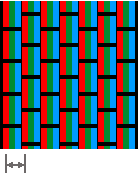
Capitalising on the advantages of both the shadow mask and aperture grill approaches, NEC has developed a hybrid mask type which uses a slot-mask design borrowed from a TV monitor technology originated in the late 1970s by RCA and Thorn. Virtually all non-Trinitron TV sets use elliptically-shaped phosphors grouped vertically and separated by a slotted mask.
In order to allow a greater amount of electrons through the shadow mask, the standard round perforations are replaced with vertically-aligned slots. The design of the trios is also different, and features rectilinear phosphors that are arranged to make best use of the increased electron throughput.
The slotted mask design is mechanically stable due to the criss-cross of horizontal mask sections but exposes more phosphor than a conventional dot-trio design. The result is not quite as bright as with an aperture grill but much more stable and still brighter than dot-trio. It is unique to NEC, and the company capitalised on the design’s improved stability in early 1996 when it fit th first ChromaClear monitors to come to market with speakers and microphones and claimed them to be the new multimedia standard.
- The Anatomy of a CRT Monitor (and CRT TVs)
- CRT Monitor Resolution and Refresh Rates (VSF)
- Monitor Interlacing
- What is the Dot Pitch of a Computer Monitor
- Dot Trio Monitors
- Grill Aperture Monitors
- Monitor Technologies: Slotted Mask
- Enhanced Dot Pitch Monitors
- Electron Beam Monitors
- Monitor Controls
- The Different Types of CRT Monitors – From ShortNeck to FST
- What is a Digital CRT Monitor and How Does It Work
- What is LightFrame Technology?
- Safety Standards For Computer Monitors
- TCO Monitor Standards
- Monitor Ergonomics